| 23 February |
• yesterday • tomorrow |
| Optional Memorial of Saint Polycarp, Bishop and Martyr |

• 24 February (monastery of Bivongi, Italy)
• 24 June (dedication of the church named in his honour)
• Giovanni Terestes
• Giovanni Teresti
• Giovanni Theristis
• Giovanni Theristus
• Giovanni of Palermo
• Giovanni the Harvester
• Giovanni the Reaper
• John...
When his mother was pregnant with "Giovanni" (we don't know his birth name), she was enslaved and taken to Palermo, Sicily by Saracen raiders; his father, Arconte di Cursano, a farmer, was killed in the same attack. His mother raised Giovanni as a Christian as best she could, though there were no churches or clergy in the Saracen controlled area. At age 14, Giovanni escaped from Sicily in a small boat, a hand-held cross as his only possession. His boat grounded at the small town of Stilo, Italy. He told the people who found him that he wanted to be Baptized, so they handed him over to their bishop. The bishop first suspected that the boy, who was dressed as a Moor, might be involved with Saracen raiding parties, but eventually realized that he was truthful, and baptized him into the faith at one of the old monastaries around the town; the bishop‘s name was Giovanni, and the boy took that as his new name.
Living among Christians, Giovanni began feeling a call to religious life. This led him to study with the monks who lived in the caves around Stilo. He particularly learned from two ascetic Basilian monks, Ambrose and Nicola, and joined the Basilians while still a young man. He became abbot of the community. Abbot Giovanni founded the monastery at Bivongi, Italy; the house was later re-named in his hounour.
There are a number of stories about Giovanni that have survived, some miraculous, others mundane and simply show the man's concern for the poor and dedication to Christian life and the Basilian Rule –
• The boat young Giovanni used to escape from Palermo had no oars or sails, but carried the boy safely to Stilo without them.
• While at sea, the boat was spotted by Turkish raiders. When the raiders approached the boat, it hid from them by sinking beneath the water; it re-surfaced after the raiders had sailed on. Giovanni, of course, was fine.
• Brother Giovanni would help reapers in the field and then give all he had earned to the poor.
• Abbot Giovanni once prayed for help to save a harvest that was about to be destroyed by a storm; an angel appeared and instantly harvested the crop, saving the peasants from starving.
• In another instance, he prayed for help to save a harvest from a storm. The storm stopped moving and waited until the crop was harvested by the locals; Giovanni then stopped praying, and the storm moved on over the field.
• When he learned of treasure that belonged to his family from before the Saracen raid that killed his father, he distributed the new-found wealth to the poor.
• In one of the caves near the Basilian monastery is a spring of water; in winter, Giovanni would stand in the icy waters to pray.
• Ruggero il Guiscardo, suffering from an incurable sore on his face, was healed upon contact with Giovanni's tunic.
c.995 in Palermo, Italy
• c.1050 in Stilo, Calabria, Italy of natural causes
• relics in the church of San Giovanni Theristi in Stilo, Italy
Stilo, Italy
sickle, bread, flask of wine
https://catholicsaints.info/saint-giovanni-theristi/

Associate of, converted by, and disciple of Saint John the Apostle. Friend of Saint Ignatius of Antioch and Saint Papias; spiritual teacher of Saint Irenaeus of Lyon. Fought Gnosticism. Bishop of Smyrna (modern Izmir, Turkey). Revered Christian leader during the first half of the second century. The Asia Minor churches recognized Polycarp's leadership and chose him representative to Pope Anicetus on the question the date of the Easter celebration. Only one of the many letters written by Polycarp has survived, the one he wrote to the Church of Philippi, Macedonia. At 86, Polycarp was to be burned alive in a stadium in Smyrna; the flames did not harm him and he was finally killed by a dagger, and his body burned. The Acts of Polycarp's martyrdom are the earliest preserved reliable account of a Christian martyr's death. Apostolic Father.
c.69
• stabbed to death c.155 at Smyrna
• body burned
• against dysentery
• against earache
Stand fast, therefore, in this conduct and follow the example of the Lord, 'firm and unchangeable in faith, lovers of the brotherhood, loving each other, united in truth,' helping each other with the mildness of the Lord, despising no man. - Polycarp, Letter to the Philippians
When the pyre was ready, Polycarp took off all his outer clothes and loosened his under-garments. There and then he was surrounded by the material for the pyre. Whey they tried to fasten him also with nails, he said, "Leave me as I am. The one who gives me the strength to endure the fire will also give me strength to stay quite still on the pyre, even without the precaution of your nails." So they did not fix him to the pyre with nails, but only fastened him instead.
Looking up to heaven, he said, "Lord, almighty God, Father of your beloved and blessed Son Jesus Christ, through whom have come to the knowledge of yourself, God of angels, of powers, of all creation, of all the race of saints who live in your sight, I bless you for judging me worthy of this day, this hour, so that in the company of the martyrs I may share the cup of Christ, your anointed one, and so rise again to eternal life in soul and body through the power of the Holy Spirit.
"I praise you for all things, I bless you, I glorify you through the eternal priest of heaven, Jesus Christ, your beloved Son. Through him by glory to you, together with him and the Holy Spirit, now and for ever. Amen."
When he had said, "Amen" and finished the prayer, the officials at the pyre lit it. But, when a great flame burst out, those of us privileged to see it witnessed a strange and wonderful thing. Like a ship's sail swelling in the wind, the flame became as it were a dome encircling the martyr's body. Surrounded by the fire, his body was like bread that is baked, or gold and silver white-hot in a furnace, not like flesh that has been burnt. So sweet a fragrance came to us that it was like that of burning incense or some other costly and sweet-smelling gum. - from a letter by the Church of Smyrna on the martyrdom of Saint Polycarp
https://catholicsaints.info/saint-polycarp-of-smyrna/

• Serenus of Billom
• Serenus of Sirmio
• Serenus of Sirmium
• Cerneuf, Sereno, Serenusa, Sireno, Sinero, Sirenatus
10 May (in Billum, France)
Serenus abandoned his home and people to live as a hermit in Sirmiun, Pannonia (modern Hungary) where he directed his thought to prayer, his labour to working a garden of fruit and herbs.
One day he found a woman and her daughters walking in the garden around noon. He recommended they withdraw, and return in the cool of the evening, but the way he said it led her to believe he was simply chasing them out. The woman's husband was an imperial guard, and he convinced Emperor Maximian to avenge this imagined insult. Serenus was arrested and brought to trial, but simply repeated what he had said, and was immediately acquitted. However, his demeanor led the judge to suspect that Serenus was a Christian, which was illegal. When questioned about it, Serenus admitted his faith. He was ordered to sacrifice to pagan gods; he refused, and was sentenced to death.
His story was very popular in times past due to his being a simple man brought to ruin not through any fault of his own, but as a result of the arrogance of the ruling class, a theme which has resonated in many an age, and because many writers and preachers liked to use the metaphor of the garden as an example of a proper Christian life.
Greece
beheaded 23 February 303 at Sirmiun, Pannonia (modern Hungary)
• bachelors
• falsely accused people
• gardeners
It has pleased God to reserve me for this present time. It seemed awhile ago as if he rejected me as a stone unfit to enter his building, but he has the goodness to take me now to be placed in it; I am ready to suffer all things for his name, that I may have a part in his kingdom with his saints. - Serenus at his trial
https://catholicsaints.info/saint-serenus-the-gardener/

Villigiso, Willigiso
Son of a wheelwright. Well educated. Priest. Canon at Hildesheim, Germany. Noted speaker. Chaplain to Emperor Otto II. Chancellor of Germany in 971. Archbishop of Mainz, Germany in 973. Archchancellor of the Holy Roman Empire in 975. Vicar apostolic to Germany in 975, ordained by Pope Benedict VII. He crowned the infant Otto III as Holy Roman Emperor in 983, and served in the regencies of Empress Theophano and Empress Adelaide. Assisted at the consecration of Pope Gregory V in 996. Participated in the synod in 996, and spoke for the return of Saint Adalbert of Prague, whom he had consecrated as bishop, to his diocese. Worked to insure the choice of Emperor Henry II in 1002, and consecrated the the emperor. Presided at the Synod of Frankfort in 1007. He sent missionaries to Scandinavia, founded churches, built roads and bridges, supported artists and monasteries, and rebuilt the cathedral of Mainz. Though he was known as a brilliant statesman and politician, he was a Church man first, and was also known for the care he took in educating priests, and choosing them for their assignments.
at Schoningen, Germany
• 23 February 1011 of natural causes
• interred in the Church of Saint Stephen
bishop with a wheel, a symbol of his father's trade, and an emblem he had chosen for his coat of arms
https://catholicsaints.info/saint-willigis-of-mainz/

• Giuditta Vannini
• Giuseppina Vannini
Orphaned as a small child. Raised in the Torlonia Conservatory on Via Sant' Onofrio, under the guidance of the Daughters of Charity of Saint Vincent de Paul. Entered the Daughters' novitiate in Siena, Italy, but was forced to leave due to poor health.
On retreat in 1891 she met Blessed Louis Tezza, procurator general of the Camillians. He had been thinking of founding a women's community for the care of the sick. He invited Josephine to help establish the new community, she prayed over it, and decided "yes." In 1892 she and two companions received the scapular of Camillian tertiaries, and a year later professed private vows, adding service to the sick, even at risk of their lives. They took their perpetual vows in 1895, and Josephine was elected Superior General. Blessed Louis was sent to Lima, Peru in 1900, responsibility for the new congregation rested with Mother Vannini, and under her leadership the congregation spread to France, Belgium and Argentina.
7 July 1859 at Rome, Italy
23 February 1911 in Rome, Italy of natural causes
on 13 May 2019 Pope Francis promulgated a decree of a miracle received through the intercession of Blessed Josephine
https://catholicsaints.info/blessed-josephine-vannini/
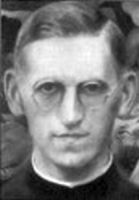
• Ludivico Mzyk
• Ludvig Mzyk
12 June as one of the 108 Polish Martyrs
The fifth of ten children born in the family of a pious coal miner. Early feeling a call to the priesthood, Ludwyk entered the seminary in Heiligenkreuz in his teens; when there was a break in the classes, he would go home to work in the mines to help support his family. Joined the Society of the Divine Word. He continued his theological studies at the Pontifical Gregorian University in Rome, Italy. Ordained a priest on 30 October 1932. Served three years as director of novices at the Chludowie monastery near Poznan, Poland where he taught theology, and became rector of the house. When the German army invaded Poland in 1939, Father Ludwyk came into immediate conflict with the Gestapo for trying to defend his novices against Nazi demands and propaganda. He was arrested on 25 January 1940, and assigned to barracks 7 at the Poznan death camp. Between bouts of torture, Ludwyk ministered to other prisoners until the Nazis finally gave up trying to break him and simply killed him. Martyr.
22 April 1905 in Chorzów, Slaskie, Poland
23 February 1942 in Poznan, Wielkopolskie, Poland
13 June 1999 by Pope John Paul II
https://catholicsaints.info/blessed-ludwik-mzyk/
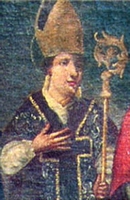
Alerino Rembaudi
Born to the Italian nobility, from his youth Alerinus was drawn to religious life. He became a canon of the cathedral of Alba, Italy, and was chosen bishop of Alba by Pope Martin V on 10 September 1419; he led the diocese for over 36 years.
Following a vision, Bishop Alerino rediscovered the lost burial site and relics of Blessed Theobald Roggeri on 31 January 1429; legend says that all the bells of the local churches rang out on their own the next morning. Alerino conducted the Synod of Alba in 1434. He invited the Augustinians to work in his diocese, supported the vocation and work of Blessed Margaret of Savoy, and in 1446 he laid the first stone of her Dominican monastery. On 27 April 1455, he translated the relics of Saint Frontiniano and others to the cathedral in Alba, and proclaimed 27 April to be the feast of the patrons of the city of Alba.
late 14th century in Alba, Cuneo, Italy
21 July 1456 of natural causes
https://catholicsaints.info/blessed-alerinus-de-rambaldis/
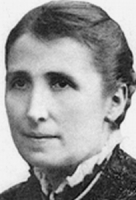
Born to a wealthy and pious family, the daughter of Gutiérrez de Cabiedes and Rosaria de Arambarri y Mancebo. Rafeala was a pious girl, made her first Communion at age 11, and was given to long meditations on the suffering of Christ. In 1861, at age 18, she married the wealthy and pious Giuseppe Vilallonga of Catalonia. The couple had seven children of their own, and took in many relatives who were poor, sick, frail or neglected. In her mid-thirties, and with Giuseppe's approval, Rafaela took personal vows of poverty, obedience and chastity. Widowed, she spent her life and fortune caring for others. She founded the Institute of the Sisters of Guardian Angels to work with abandoned and neglected children.
16 January 1843 in Bilbao, Vizcaya, Spain
23 February 1900 in Bilbao, Vizcaya, Spain
30 September 1984 by Pope John Paul II
https://catholicsaints.info/blessed-rafaela-ybarra-arambarri-de-villalonga/
Primiano, Primus
In 1376, a pious woman in Ancona, Italy, named Cecola, had a dream in which Saint Primianus appeared to her; he was dressed as a bishop and explained that he had been martyred for the faith over 1,000 years earlier, that his body had been taken from a pagan area to Ancona by sailors, and that he been buried in a long forgotten spot in the church of Sante Maria in Turriano near the city port. Church authorities found the grave, and writings there indicated that the interred was a Greek and a bishop. When word spread about the incident, devotion to Saint Primianus began, and the church was soon re-dedicated to him.
Greece
• buried in the church of Sante Maria in Turriano in Ancona, Italy; this church was later re-named Saint Primianus
• relics later enshrined in a new church of Saint Primianus built on the site of the original
• church restored and relics re-enshrined in the late 8th century
• church and relics destroyed by bombing in World War II
https://catholicsaints.info/saint-primianus-of-ancona/
Sister Maria Rosaria
Raised in an Evangelical family, Elfrieda converted to Catholicism at age 20, and joined the Sisters of Saint Elizabeth. She served in various, often administrative capacities, at Elizabethan Sister houses in Hamburg-Eimsbüttel, in Glogów, in Nysa, in Katowice, in Legnica, in Chojnów and in Nowogrodziec. When the Soviet army overran the area near the end of World War II, she and some other Sisters hid in an air-raid shelter. When the Russian soldiers found them, she struggled against them but was beaten, gang raped by the soldiers, and finally murdered by the Communist party commisar Martyr.
5 May 1908 in Wroclaw, Poland
shot twice on 23 February 1945 in Nowogrodziec (a.k.a. Naumburg am Queis), Boleslawiec, Poland
11 June 2022 by Pope Francis
"Jesus, Mary." – Blessed Elfrieda's dying words, whispered between the two shots that killed her
https://catholicsaints.info/blessed-elfrieda-schilling/
Alexandros
Born to the nobility. Studied in Constantinople. Soldier and officer in the imperial army for four years. Adult convert to Christianity who read himself into the faith, and took his example from the words of Christ to the young rich man - he sold all his goods and became a hermit in Syria for several years. At one point he came back to the city; there he burned a pagan temple, and was imprisoned; he spent his time there bringing his jailers to Christianity. Released, he returned to the life of a hermit for several years, but felt called missionary work, and worked in Antioch, but with no success. Founded monasteries in Mesopotamia, Constantinople and Gomon, and at one point led 400 monks. Converted Rabulas, bishop of Edessa. Alexander began the liturgical service in which his monks sang the Divine Office continuously day and night.
4th century on one of the Aegean Islands of Greece
403 in Gomon of natural causes
https://catholicsaints.info/saint-alexander-akimetes/
Daughter of an imperial Roman official, Romana was drawn to Christianity. Around age 16, to avoid marriage, she fled her family home. With the help of an angel, she made it to the cave on Mount Soracte where Pope Saint Sylvester was hiding from the persecutions of Diocletian. She explained to him her desire for Christian religious life; he baptized her and left, leaving her the cave as a home. Her reputation for holiness soon spread, and she attracted so many students that they founded a community around her cave.
While such a saint may well have lived in the cave, and such people certainly attracted would-be students and followers, the tales that grew up around her are likely pious fiction that was later mistaken for history.
c.308
• c.324 in her cave on Mount Soracte near Rome, Italy of natural causes
• her parents were brought to the cave, and buried her there
https://catholicsaints.info/saint-romana/

Milburg, Milburge, Mildburg, Mildburga, Milburgh, Mildburh
25 June (translation of relics)
Daughter of Merewalh, King of Mercia, and Saint Ermenburga. Sister of Saint Mildred and Saint Mildgytha. Took the veil from archbishop Saint Theodore. Benedictine nun. Founded Much Wenlock abbey in Shropshire, England, and was abbess there. Miracle worker. Had a mysterious power over birds; they would avoid damaging the local crops when she asked them to.
7th century England
• 715 at the Much Wenlock Abbey, Shropshire, England of natural causes
• relics re-discovered in 1101 and enshrined in the nearby priory church
birds
https://catholicsaints.info/saint-milburga/
73 Christians who were martyred together in the persecutions of Diocletian. We know no details about them, and only six of their names - Antigonus, Libius, Rogatianus, Rutilus, Senerotas and Syncrotas.
c.303 at Syrmium, Pannonia (modern Sremska Mitrovica, Serbia)
https://catholicsaints.info/martyrs-of-syrmium-23-february/
• Madonna del Divin Pianto
• Our Lady of the Divine Weeping
• Beata Vergine Maria del Divin Pianto
Commemorates the apparition of the Blessed Virgin Mary to Sister Elisabetta Redaelli, a member of the Sisters of Santa Marcellina, in Cernusco sul Naviglio, Milan, Italy on 6 January 1924 and 23 February 1924. The messages given in the vision were about the need for prayer and hope, and for all Christians, especially those in religious orders, to actively seek Jesus. The archdiocese of Milan has never proclaimed the incident as supernatural, but Cardinal Carlo Maria Martini, while archbishop of Milan, authorized the Madonna del Divin Pianto parish church in Cernusco sul Naviglio.
https://catholicsaints.info/our-lady-of-the-divine-cry/

Ordained on 13 March 1937. Arrested by the Gestapo in 1939, Stefan was shuttled through the concentration camps Fort Seven, Stutthof, Grenzdorf, Oranienburg-Sachsenhausen and finally Dachau. Spiritual leader of other prisoners wherever he was imprisoned. He contracted typhus while working with fellow prisoners dying of the disease, and is thus considered a martyr of charity.
22 January 1913 in Chelmza, Poland
23 February 1945 of typhus at the Dachau concentration camp, Germany
7 June 1999 by Pope John Paul II at Torun, Poland
https://catholicsaints.info/blessed-stefan-wincenty-frelichowski/
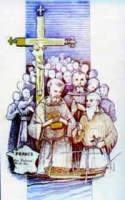
Priest in the diocese of Verdun, France. Imprisoned on a ship in the harbor of Rochefort, France and left to die during the anti-Catholic persecutions of the French Revolution. One of the Martyrs of the Hulks of Rochefort.
16 February 1745 in Bar-le-Duc, Meuse, France
23 February 1795 of unspecified disease aboard the prison ship Washington, in Rochefort, Charente-Maritime, France
1 October 1995 by Pope John Paul II
https://catholicsaints.info/blessed-nicolas-tabouillot/
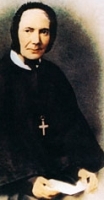
Born to a wealthy family, she grew up wanting and working to help the poor. Nun in the diocese of Como, Italy. Founded the Nursing Sisters of Our Lady of Sorrows.
24 June 1807 in Como, Italy
23 February 1872 in Como, Italy of smallpox
20 September 2014 by Pope Francis
Nursing Sisters of Our Lady of Sorrows
https://catholicsaints.info/blessed-giovannina-franchi/
• Milo of Auvergne
• Milone...
Studied for the priesthood in Paris, France. Priest in Auvergne, France. Canon of the cathedral of Auvergne. He was the teacher of the young Saint Stephen of Muret. Milo's reputation for piety led to the people of Benevento, Italy to choose him as their bishop where he served the remaining two years of his life.
Auvergne, France
c.1073 in Benevento, Italy of natural causes
https://catholicsaints.info/blessed-milo-of-benevento/

Virgin martyr in the persecutions of Decius.
• beheaded in 250 at Astorga, Spain
• relics enshrined in the abbey of Ribas de Sil and at Ters
Astorga, Spain
https://catholicsaints.info/saint-martha-of-astorga/
Braulio Carlos
Professed religious in the Brothers of the Christian Schools (De La Salle Brothers). Martyred in the Spanish Civil War.
10 December 1913 in Cortiji-Lorca, Murcia, Spain
23 February 1937 in Madrid, Spain
13 October 2013 by Pope Francis
https://catholicsaints.info/blessed-juan-lucas-manzanares/
Boisil
Spiritual student of Saint Aidan of Lindisfarne. Monk. Abbot at the abbey of Melrose, Scotland. Teacher and spiritual director of Saint Cuthbert of Lindisfarne and Saint Eghert. Bible scholar. Had the gift of prophecy. Noted preacher.
Northumbrian (in modern England)
• 661 of the yellow plague
• relics at Durham, England
https://catholicsaints.info/saint-boswell/
Merald, Merault, Meraut, Meraldo, Medraldo
Benedictine monk at Saint-Evroult, Ouche, France. Abbot of Vendôme, France in the mid-9th-century.
• 850 of natural causes
• relics transferred to Vendôme, France in 1288 to protect them during the Norman invasions
https://catholicsaints.info/saint-medrald/
15th century Franciscan friar. His body is enshrined in the church of Santa Maria della Pace in Milan, Italy, but all records about him have been lost, and we know nothing about him.
1481
https://catholicsaints.info/blessed-anselm-of-milan/
Dositheus of Gaza
Sixth-century desert hermit whose deep prayer life led to deep personal holiness.
Egypt
https://catholicsaints.info/saint-dositheus-of-egypt/
Hermit in Syria. Spiritual teacher of many monks, including Saint Maro and Saint Polychronius.
5th century of natural causes
https://catholicsaints.info/saint-zebinus-of-syria/
Bishop of Brescia, Italy for 40 years. Fierce opponent of Arianism.
6th century
650
https://catholicsaints.info/saint-felix-of-brescia/
Priest in Rome, Italy who was known for his ministry to people imprisoned for their faith.
c.300
https://catholicsaints.info/saint-polycarp-of-rome/
French
1287 of natural causes
https://catholicsaints.info/blessed-john-of-hungary/
Benedictine monk in Sahagun, Leon, Spain. Bishop of Astorga, Spain in 1062.
1066 of natural causes
https://catholicsaints.info/saint-ordonius/
Martyr.
c.485 in Seville, Spain
https://catholicsaints.info/saint-florentius-of-seville/
• Our Lady of the Rocks
CatholicSaints.Info Portable Edition